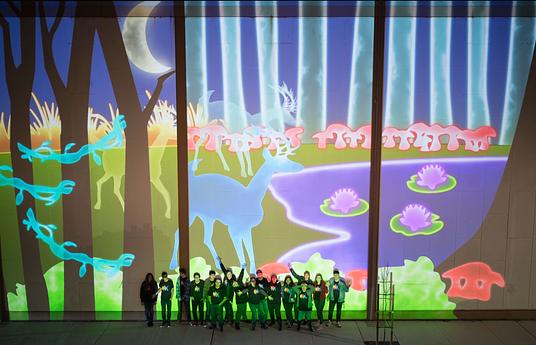The nationally and internationally recognized Global Create-a-thon project is a design challenge where student artwork and animations are created both digitally and traditionally. The work is then incorporated into various Lighted Art Festivals around the world — including one in downtown Napa that takes place each January.
The driving force in this project is to give students the platform and voice to show their creativity to the world. Often times, as adults, we seek to control the creative process for students, teaching them a technique, or indicating the final product that we expect from them. In stark contrast, Global Create-a-thon students are empowered to learn new digital tools they are interested in, pursue their own creative ideas, solve their own problems as they seek to create visual and auditory artwork, and then showcase their work to the world on the side of a 70-foot wall. The power of creative freedom, married with mentorship from industry experts and teachers is what allows for pure learning magic.

A typical day in the project-based learning class in charge of the Global Create-a-thon might look at bit messy and chaotic. The top digital design students at New Technology High School in Napa, CA are in charge. What you won’t usually see, is a teacher at the front of the classroom giving a lecture. Most of the teaching happens behind the scenes and in one-on-one sessions. Students run the show, make key decisions about how the project will unfold, run team meetings, set agendas, and learn and teach one another when the need arises, all while the teacher plays the role of a mentor and guide.
On any given day you might see a small group of student leaders gathered around a table, reviewing the calendar and setting deadlines for the Napa Lighted Art Projection Show. At another, a student might be working on a Public Relations blurb explaining the overall art piece and how the class created it. Across the way, a team might be putting together a slide deck in preparation for a public “Artist Meet and Greet” in January. In the corner, the self-appointed student documentarian is interviewing classmates while a small group is video-chatting with a teacher in Kenya to discuss how students in Africa can collaborate with the students in California. The class officially begins when two students get up in front of the class to announce what the day’s tasks are for the project.
The classroom becomes a laboratory for high school students to test their skills and stretch in ways they never knew they could in a high risk, high visibility project. The Napa Lighted Art Festival, alone, had a total of 20,000 visitors in 2019 and expects to double its audience in the year 2020. Students know that their work will have a very real impact on the world and this is a fundamental key to learning engagement.

According to the 2019 study by Adobe: Creativity and Education: Why it matters, 71% of college-age professionals say creative thinking should be taught as a course, like math and science. 78% say that creativity is very important to their career and 82% wish they had more exposure to creative thinking as students. But in a rush to cover content, teachers and administrators are forgetting to make space and time for students to explore their creativity. This project allows youth to explore their creativity as well as amplifies student voice in the greater community. Participating alongside international artists has shown our youth that not only does their viewpoint matter, but they can create artwork at the same level as professional adults. The project gives the youth an opportunity to learn about creating an art product that is worthy of any lighted show around the world while learning leadership, communication, and time/resource management skills. They learn about iteration, the design process, and collaboration as a key to artistic success. The entire show is created from scratch by youth, is led by youth, and is implemented totally by youth.
This year students have encountered many questions and obstacles as they put together the Global Create-a-thon: How do we collect artwork from around the world? How will we incorporate that artwork into the show in a way that makes sense and has the most impact on the audience? How do we get the word out to the world that we are asking for submissions? How do we best work with mentors from the community? How will we sustain this project from year to year? Who do we need to recruit from within our own class to continue on in leadership roles?
Allowing students to flourish in the future economy means teaching students how to understand problems, find their own solutions, manage their time and resources and learn to work together. Providing a very real sense of agency over their own learning can only happen by letting students sit in the driver’s seat, with trusted adults there to whisper in their ears, make suggestions and give valuable feedback. The Global Create-a-thon is just the opportunity for them to do so.
If you want to know more about Global Create-a-thon, check out their innovation page.



